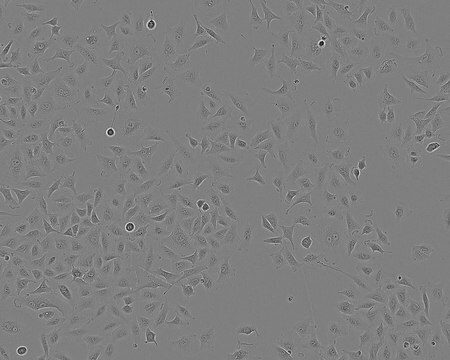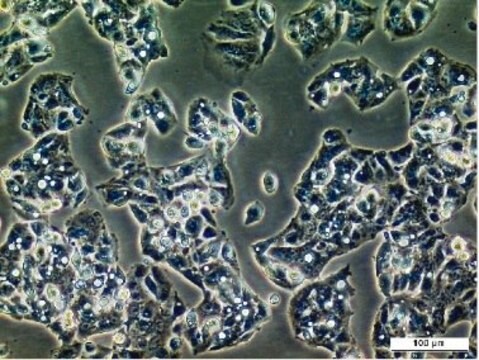LNCap Clone FGC Cell Line human
NOTE: Both the cell line and DNA from the cell line may be available for this product. Please choose -1VL or VIAL for cells, or -DNA-5UG for DNA, 89110211, human prostate (carcinoma), Epithelial-like
Synonim(y):
Komórki LNCaP-FGC
About This Item
Polecane produkty
pochodzenie biologiczne
human prostate (carcinoma)
opakowanie
tube of 5 μg 89110211-DNA-5UG
pkg of vial of cells 89110211-1VL
tryb wzrostu
Adherent
kariotyp
Pseudodiploid male; seven marker chromosomes, modal number 46, range 33 to 91
morfologia
Epithelial-like
produkty
Prostate acid phosphatase, prostate specific antigen
receptory
Androgen, estrogen
metody
cell culture | mammalian: suitable
powiązane choroby
metastasis
Warunki transportu
dry ice
temp. przechowywania
−196°C
Pochodzenie linii komórkowej
Opis linii komórkowej
Zastosowanie
- to study the effect of sex steroid hormones in regulating the expression of oligoadenylate synthetase 1 (OAS1)
- to study the role of curcumin and resveratrol in redox control and ability to promote apoptosis
- to investigate low molecular weight thiols present in the deproteinized extract of the cell line after derivatization
pożywka hodowlana
Rutyna subkultury
Inne uwagi
Wybierz jedną z najnowszych wersji:
Certyfikaty analizy (CoA)
It looks like we've run into a problem, but you can still download Certificates of Analysis from our Dokumenty section.
Proszę o kontakt, jeśli potrzebna jest pomoc Obsługa Klienta
Masz już ten produkt?
Dokumenty związane z niedawno zakupionymi produktami zostały zamieszczone w Bibliotece dokumentów.
Nasz zespół naukowców ma doświadczenie we wszystkich obszarach badań, w tym w naukach przyrodniczych, materiałoznawstwie, syntezie chemicznej, chromatografii, analityce i wielu innych dziedzinach.
Skontaktuj się z zespołem ds. pomocy technicznej


